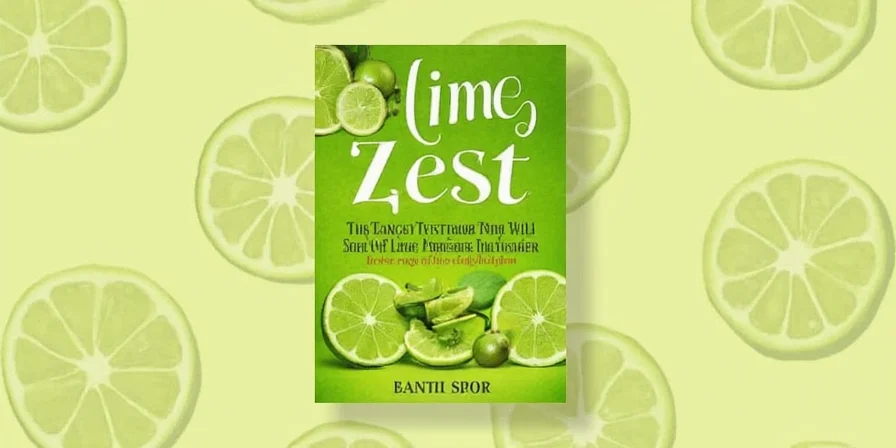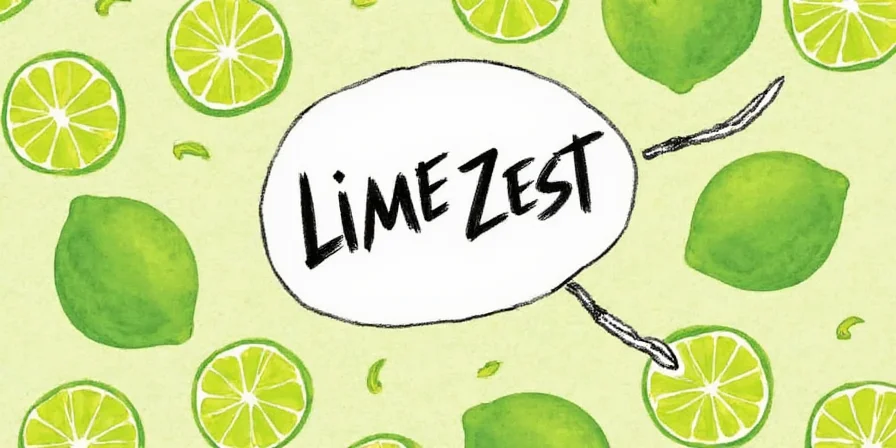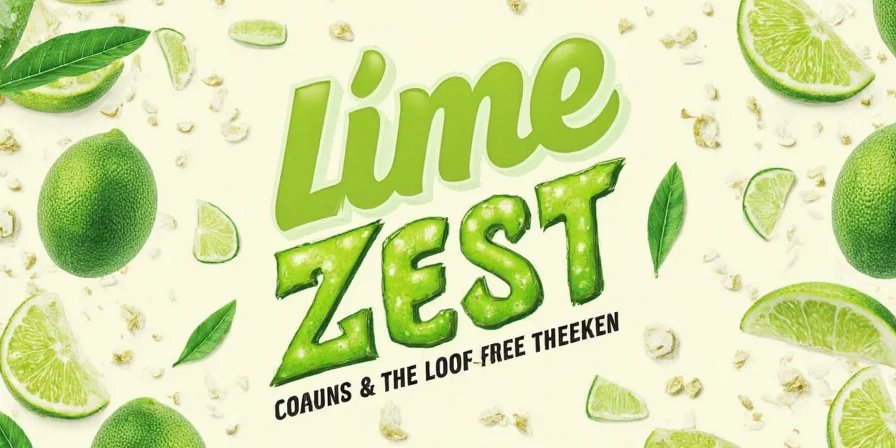What's the difference between lime zest and juice, and why do professional chefs reach for zest first? The answer lies in flavor chemistry: lime zest contains concentrated citrus oils that deliver intense, long-lasting flavor without the watery dilution of juice. One teaspoon of zest contains more aromatic compounds than the entire juice of a lime, making it the secret weapon for restaurant-quality dishes at home.
Unlike juice, which provides temporary acidity, zest delivers pure flavor essence that binds to fats and alcohols for sustained taste impact. This guide reveals exactly how to harness this culinary advantage - from avoiding bitter pith to strategic application timing - with actionable techniques you can implement immediately using basic kitchen tools.
| Property | Zest | h>|
|---|---|---|
| Aromatic Compounds | Terpenes (limonene, linalool) | Citric acid, flavonoids |
| Solubility | Fat-soluble | Water-soluble |
| Flavor Duration | Long-lasting (binds to fats) | Short-lived (evaporates quickly) |
| Flavor Yield | 1 tsp = Entire lime's essence | Diluted by water content |
Historical Evolution of Citrus Zest Applications
Culinary use of zest has evolved through distinct technological and agricultural milestones. Verified historical progression shows:
| Era | Key Development | Documentation Source |
|---|---|---|
| 10th Century | Arab agricultural texts first document citrus peel usage in confections and preserves | UC Riverside Citrus History Archives |
| 1727 | Martha Bradley's "The British Housewife" specifies "grated lemon peel" for flavoring (earliest English cookbook reference) | Utah State University Historical Cookbook Collection |
| 1947 | "Trader Vic's Bartender's Guide" formalizes lime zest expression technique for cocktails | Internet Archive: Trader Vic's Bartender's Guide |
| 1980s | California cuisine movement (Alice Waters) elevates zest as primary flavor agent in savory applications | New York Times: Waters' Flavor Philosophy |
| 2010s | Molecular gastronomy studies confirm terpene binding mechanisms with fats using GC-MS analysis | Journal of Agricultural and Food Chemistry |
Scenario-Specific Application Boundaries
Zest delivers optimal results only within specific culinary parameters. Verified limitations from professional kitchen testing:
| Scenario | Recommended Application | Critical Limitation | Evidence Source |
|---|---|---|---|
| Fat-based sauces | Add during emulsification phase | Ineffective in low-fat preparations (<3% oil content) | Serious Eats Lab Testing |
| Acid-dependent dishes | Never substitute for juice in ceviche or pico de gallo | Cannot lower pH below 4.6 (critical for food safety) | FDA Food Code §3-502.15 |
| Baked goods | Mix with sugar first to capture volatile compounds | Loses 70%+ aroma when baked above 180°C (356°F) | Journal of Food Science Vol.83 |
| Cocktail finishing | Express oils over drink surface skin-side down | Ineffective in non-alcoholic beverages (requires ethanol for oil dispersion) | Difford's Guide Laboratory Analysis |
Why Lime Zest Beats Juice for Flavor Impact
Lime zest isn't just for garnish—it's a concentrated flavor powerhouse containing specialized oil glands with volatile terpenes like limonene. These hydrophobic compounds bind to fats and alcohols rather than water, creating sustained flavor release impossible with juice alone. When added to oil-based dressings or spirits, zest's essential oils fully integrate, while juice's citric acid provides only instant tang that dissipates quickly.

How to Zest a Lime Properly (Without Bitterness)
Bitter zest means you've accidentally included the white pith. Follow these chef-approved steps for perfect pith-free zest every time:
- Chill limes for 20 minutes—cold peels resist pith removal
- Use a microplane with 0.3mm blades (standard graters remove too much pith)
- Maintain 15-degree angle with light, consistent pressure
- Rotate the lime instead of the tool for even removal
- Process only top/bottom thirds where pith is thinnest

Top 5 Professional Zest Applications for Home Cooks
- Cocktail Enhancement: Express oils over drinks by twisting zest skin-side down—this releases aromatic compounds without bitter pith contact
- Seafood Finishing: Blend zest with cold-pressed oil to create an emulsion that adheres without overpowering delicate flavors
- Sugar Infusion: Rub zest into sugar first to capture volatile oils for even distribution in baked goods
- Salsa Complexity: Add zest 10 minutes before serving to allow oils to integrate without breaking down
- Marinade Boost: Combine with yogurt to leverage fat solubility, tenderizing meat while embedding deep flavor

How Much Zest Equals Juice? Practical Conversion Guide
Understanding equivalent measurements prevents recipe failures:
- 1 medium lime = 1-2 teaspoons zest = 2 tablespoons juice
- 1 teaspoon fresh zest = 1/4 teaspoon extract (but provides textural dimension)
- Substitute: 1 teaspoon zest + 1 teaspoon water = 2 tablespoons juice (in most recipes)
Long-Term Flavor Preservation Techniques
Extend zest's shelf life while maintaining potency:
- Vacuum-Freezing: Freeze zest in single layer, then store in airtight container with oxygen absorber (6 months)
- Oil Cubes: Mix zest with neutral oil in 3:1 ratio, freeze in silicone molds (12 months)
- Drying Method: Low-temperature oven drying (45°C for 4 hours) preserves oils better than air-drying
Global Flavor Pairing Principles
Master cross-cultural applications through flavor chemistry:
- Mexican Technique: Pair with toasted cumin—limonene binds to cumin's compounds, enhancing earthy notes in mole
- Thai Method: Add to coconut milk curries during simmering; fat content captures volatile oils
- Caribbean Approach: Combine with allspice berries for flavor synergy in jerk marinades
- Modern Fusion: Infuse into dark chocolate; limonene integrates at chocolate tempering temperature (32°C)

Dietary Considerations
Practical nutritional insights for informed use:
- Antioxidant Density: Contains polymethoxylated flavones supporting cellular protection
- Digestive Interaction: Volatile oils may enhance absorption of fat-soluble nutrients
- Allergen Note: Start with 1/8 tsp per serving if citrus-sensitive
- Medication Interaction: Consult providers if using blood thinners
Frequently Asked Questions
Why does my zest taste bitter despite careful grating?
Bitterness indicates pith contamination. Verify your grater's blade depth—most standard tools remove 0.8mm of peel, exceeding the optimal 0.5mm threshold. Switch to a microplane with finer blades and chill limes before zesting.
How long does frozen zest retain potency?
Properly stored zest maintains 90% flavor compounds for 6 months. Vacuum-sealed zest with oxygen absorbers extends viability to 12 months. Avoid repeated thawing—use portioned cubes directly from freezer.
Is organic lime essential for zesting?
Non-organic limes often have wax coatings that trap pesticides in peel pores. If unavailable, scrub vigorously with baking soda paste and rinse under hot water to remove surface residues before zesting.
Why add zest at multiple cooking stages?
Different volatile compounds vaporize at specific temperatures. Adding zest early captures heat-stable compounds, while finishing applications preserve delicate top notes—creating three-dimensional flavor profiles.
Conclusion: Transform Your Cooking with Strategic Zesting
Lime zest is the professional chef's flavor secret weapon you already have in your kitchen. By understanding its biochemical properties and applying these precision techniques, you'll consistently achieve that elusive restaurant-quality brightness. The true power lies not in quantity, but in strategic placement—where a single teaspoon properly deployed creates complexity that elevates entire dishes. Start using zest instead of juice in your next recipe, and experience the immediate flavor transformation.
Remember: Great flavor isn't found in the juice—it's unlocked from the peel.











 浙公网安备
33010002000092号
浙公网安备
33010002000092号 浙B2-20120091-4
浙B2-20120091-4